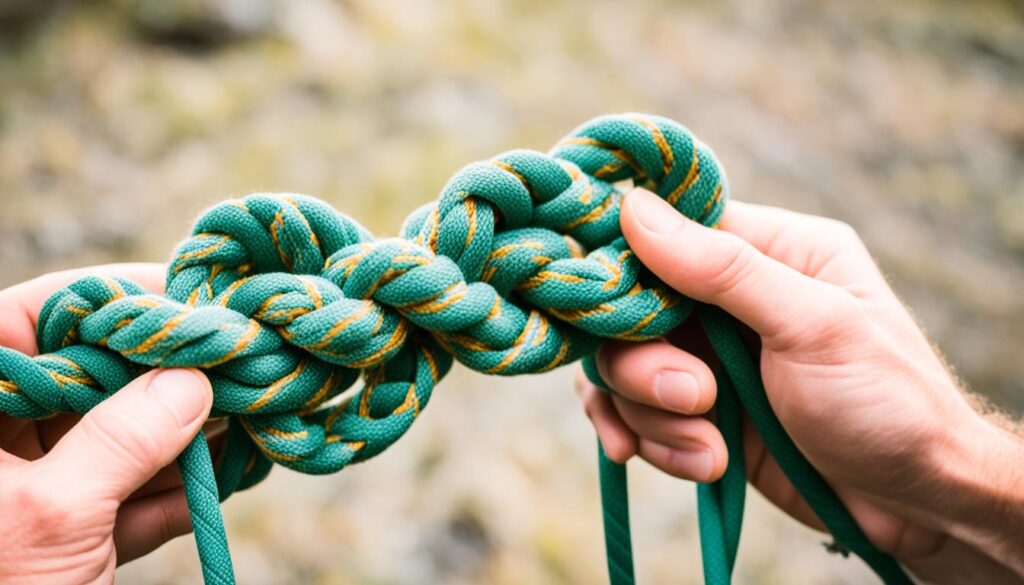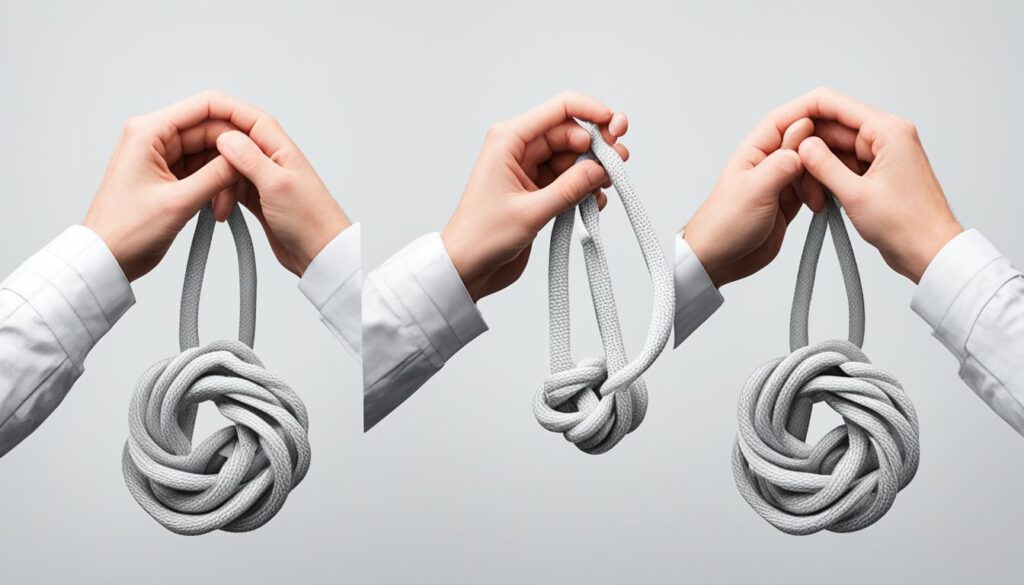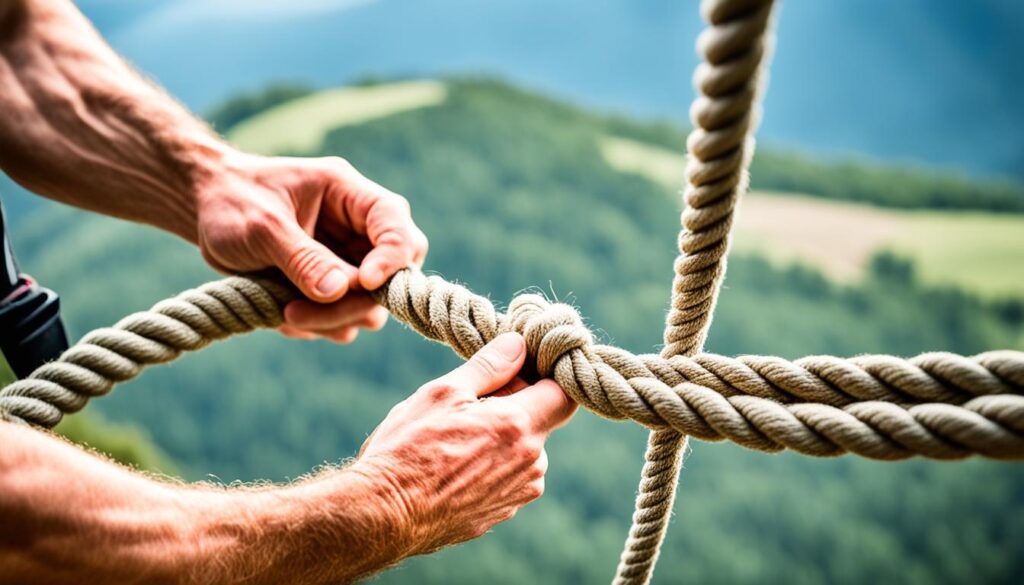Loop Knot Benefits for Fishing and Sailing
A loop knot comes in handy for activities like fishing and sailing. It enhances lure movement, making them appear more lifelike. A simple loop knot is the best start for beginners—it’s easy to tie and strong.
Key Uses of Loop Knots
Loop knots work well with specific baits like topwater and finesse plastics. There are many types, such as the famous Rapala Knot. Remember to leave a long tag end for large luresoop knot when making a l. Always connect your line directly to the lure or jighead.
How to Tie a Loop Knot
- Insert the line through the eye of the lure or hook.
- Make a loop with the line.
- Pull the knot down towards the eye.
- With practice, you’ll be able to tie it quickly and securely.
Key Takeaways
- Versatile Use: Loop knots are used in both fishing and sailing.
- Enhanced Lure Action: They give lures a lifelike appearance, increasing their effectiveness.
- Beginner-Friendly: Simple loop knots are easy to tie and very strong.
- Ideal for Certain Baits: Useful with topwater baits and finesse plastics.
- Important Precautions: Use a long tag end for larger lures to ensure strength.
When to Use a Loop Knot
Fishing: Loop knots are particularly practical with topwater baits and finesse plastics. They help lures move more naturally, attracting more fish. For bass or crappie fishing, a loop knot can significantly improve your catch rate.
Sailing: In sailing, loop knots keep ropes and lines secure on boats. This is crucial whether you’re sailing for leisure or in a race.
By mastering the loop knot, you’ll enhance your success in both fishing and sailing. Remember to practice regularly; soon, tying a loop knot will become second nature.

Variations of Loop Knots
There are many variations of loop knots suitable for all fishing levels. Selecting the right loop knot is crucial whether angler you’re aperience novice or an ex. Here are some top picks:
Rapala Knot
The Rapala Knot is renowned for its strength and adaptability. Anglers use it to create a loop at the end of the line, allowing lures and bait to move freely, which enhances their effectiveness.
Krystan Loop Knot
The Krystan Loop Knot securely attaches your line to the lure, ensuring the bait remains firm even when fighting large fish. It is a reliable choice for anglers seeking a safe and solid knot.
Simplest and Easiest Loop Knot
For some anglers, the simplest loop knot is the best choice. It’s easy to tie, handles pressure well, and makes changing lures quick and easy. This basic knot is a favorite among many anglers.
Choosing the Best Loop Knot
Selecting the right loop knot depends on your fishing style and the lures you use. It’s essential to practice tying knots and choosing one to tie smoothly and correctly. A strong loop knot is key to enjoyable and successful fishing trips.
Precautions with Tying the Simple Loop Knot
When learning to tie a simple loop knot, paying attention to details is crucial to ensure your knots are potent and effective.
Consider the Length of the Tag End
For larger bait, tie a longer loop. This creates a more giant loop, making it easier to fit the lure through. A longer tag ensures the knot works smoothly without any issues.
Hook the Loop Left on the Eye
After threading the lure through the loop, hook it with your finger. This adds control, allowing you to manage each line separately, which improves the knot’s overall strength and reliability.
By understanding and practicing these variations of loop knots, you’ll enhance your fishing experience, ensuring secure and practical connections between your line and lures.
Avoid Using a Loop Knot on a Split Ring
It’s best to avoid using a loop knot on a split ring. Doing so can disrupt the lure’s natural movement. Instead, opt for a different knot when attaching to a split ring for better performance.
How to Tie a Simple Loop Knot
To assist you in tying a simple loop knot, follow these steps:
- Pass the line through the eye of the lure.
- Create a loop by doubling the line towards the lure and holding it in place.
- Thread the tag end through the loop, ensuring it passes over the main line.
- Hold the tag and main lines separately.
- Cinch the knot down by pulling both ends simultaneously.
Keep these tips in mind, and your simple loop knot will be perfect for fishing.

Other Useful Knots for Outdoor Activities
| Knot | Use |
|---|---|
| Square Knot | Joining two rope ends of the same size together |
| Clove Hitch | Securing ropes to objects such as posts or rails |
| Cow Hitch | Securing ropes to stakes, poles, or other fixed objects |
| Bowline | Creating an adjustable loop |
| Fisherman’s Knot | Joining two lines of similar or different thicknesses |
| Sheet Bend | Joining two ropes of different thicknesses |
Learning these basic outdoor knots is crucial. They will help in many situations, from setting up camp to enjoying water sports. Mastering them makes outdoor activities safer and more enjoyable.
Conclusion
Mastering the loop knot enhances fishing and outdoor experiences by improving lure movement in the water. This versatile knot is easy to learn, making it ideal for beginners. Practice our simple tutorial to perfect your technique quickly. Experiment with different loop knot variations to find what best suits your needs, whether for fishing or sailing.
When tying the loop knot, ensure accuracy by using the right line and leaving a sufficient tag end for larger lures. Tighten the knot by pulling both lines for a secure hold. With practice, tying loop knots will become second nature, enhancing your outdoor adventures.
FAQ
How do I tie a loop knot?
Tying a loop knot is simple. Start by passing the line through the lure or hook’s eye. Then, double the line and curve it around your hand, twisting it.
Now, you should have a loop. Pass the lure or hook through this loop. Pull the knot towards the eye and make it tight. With time, you’ll master tying a loop knot.
When should I use a loop knot?
Use loop knots with topwater baits and finesse plastics. They make lures move better, catching fish’s attention. Loop knots work well in bass, multi-species, and crappie fishing, as well as in sailing.
What are the best loop knots?
The best loop knot depends on your preference. Popular ones are the Rapala Knot and the Krystan Loop Knot. Anglers often choose the simplest loop knot for ease.
Are there any precautions I should take when tying a loop knot?
Yes, consider the length of the tag end when tying a loop knot. Larger lures need a bigger loop. It’s best to hook the remaining loop on the eye and pull both the tag and main line to tighten it.
Avoid using a loop knot on a split ring to not affect the lure’s movement.
Can you provide a step-by-step guide on how to tie a loop knot?
Certainly! Here’s how to tie a loop knot:
1. Pass the line through the eye of the lure or hook.
2. Double the line around your hand to create a loop.
3. Twist the line to secure the loop.
4. Pass the lure or hook through the loop.
5. Adjust the loop size if needed.
6. Pull both the tag end and main line to tighten the knot. Practice will make it faster.
Are there any other useful knots for outdoor activities?
Yes, many knots are helpful outdoors. Some include the Square Knot, Clove Hitch, and Cow Hitch. Also, there’s the Bowline, Fisherman’s Knot, and Sheet Bend. Learning these knots enhances your outdoor knot tying skills.
What are the advantages of tying a loop knot?
A loop knot improves your fishing game by making lures move naturally. This attracts more fish. Use them for topwater baits and finesse plastics for better results.
Are there any tips for choosing the right loop knot?
Choose a loop knot that you can tie quickly and correctly. Anglers often go for the simplest option. Testing various knots helps you find the most suitable one for your needs.
